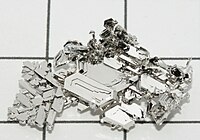
Photo from wikipedia
For the metals used in jewellery, high hardness and the associated scratch resistance are much sought after. Conventional crystalline alloys for jewellery are alloyed and extensively processed (thermally and mechanically)… Click to show full abstract
For the metals used in jewellery, high hardness and the associated scratch resistance are much sought after. Conventional crystalline alloys for jewellery are alloyed and extensively processed (thermally and mechanically) to improve hardness, but it is difficult to reach values beyond 300 HV. The advent of bulk metallic glasses (BMGs), based on precious metals and with hardness exceeding 300 HV in the as-cast state, is therefore of great interest for both jewellery and watchmaking. The non-crystalline structure of these materials not only gives high hardness, but also the opportunity to shape metals like plastics, via thermoplastic forming (TPF). For more traditional jewellery manufacture, BMGs also exhibit high-definition and near-net-shape casting. Gold-based alloys have long dominated the consideration of BMGs for jewellery as they can comply with 18 karat hallmarks. Although BMGs based on platinum or palladium possess excellent thermoplastic formability and are without known tarnishing problems, achieving useful glass-forming ability (GFA) within the more restrictive hallmarking standards typically used for jewellery (≥95 wt% platinum or palladium) is at best challenging. In this two-part review, platinum- and palladium-based BMGs are discussed, focusing on their potential application in jewellery and on the further research that is necessary.
Journal Title: Johnson Matthey Technology Review
Year Published: 2020
Link to full text (if available)
Share on Social Media: Sign Up to like & get
recommendations!